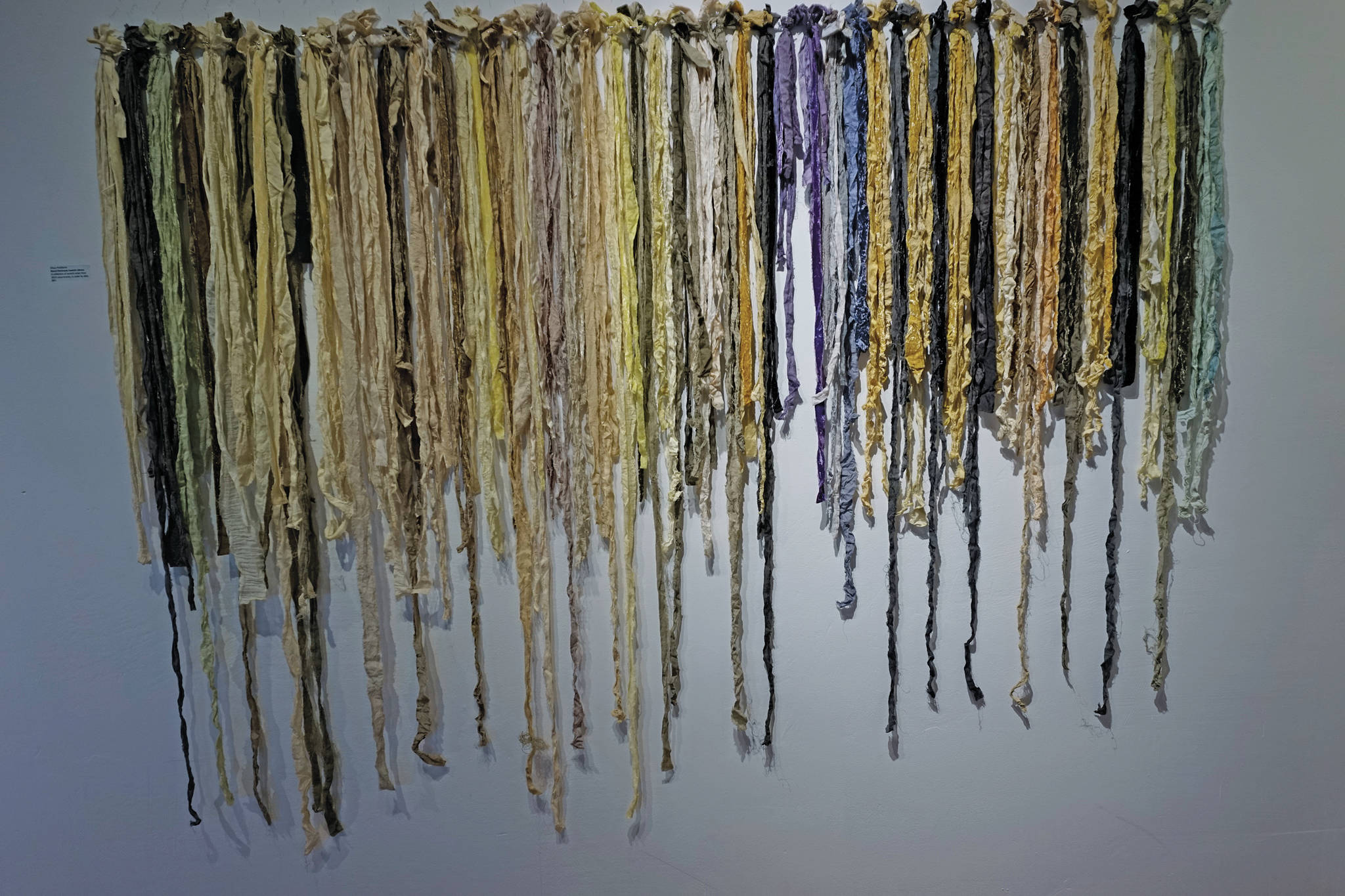Not every Homer art exhibit starts out with a chemistry experiment, but that’s the beginning of Elissa Pettibone’s “Swatches,” which is on display this month at Bunnell Street Arts Center.
The Homer artist’s show is paired with another plant-based art exhibit — Karen Stomberg’s “Traces,” a collection of botanical drawings.
While dazzling in its colors, “Swatches” also works as a really cool science project. It asks and answers the question, “What kind of organic dyes and colors can you get from southern Kenai Peninsula plants?” Pettibone pitched the idea for the exhibit to Bunnell, and started on it in May 2019 after the gallery gave her the green light.
Pettibone grew up in St. Cloud, Minnesota, and moved to Homer in 2018 from Anchorage with her artist husband, David. She got into textile dyeing as a child, but became more serious about it while working on her Bachelor of Arts in industrial design at the University of the Arts in Philadelphia. While in college she did an internship with Stony Creek Colors in Nashville, Tennessee, the biggest producer of indigo, a vivid blue dye made using a 6,000-year-old process. It’s the original dye in blue jeans.
After college she got a Center for Creative Economy small business grant from the University of the Arts and started a business doing dye work in Philadelphia. She later moved to New York City, where she did dye work for Broadway shows like “The Lion King.” In Homer, Pettibone still does dye work on commission and also teaches dyeing classes.
“I felt that teaching was a little bit more gratifying than doing stuff for people,” she said. “… It empowered other people to use plant material for color. … I always learned something. I think that’s my favorite part.”
Working in New York, many of the dyes made from petroleum and were caustic. While that taught her a lot about color matching, Pettibone found herself drawn to the historic tradition of using organic materials to make dyes.
“I feel there is a timeless quality to the dye and a more thoughtful, holistic way of adding color to the fiber,” she said in an artist talk she did last Friday in a Facebook Live video. To watch the talk, visit https://fb.watch/1GTEDqE-dA.
A three-ring binder included with Pettibone’s exhibit shows the notes she kept while working on “Swatches.” It has the dates for when she harvested plants, when she made the dye and the process used. It also includes samples of the resulting dye on different fabrics. One work in her show, “Kenai Peninsula Swatch Library,” shows some of those dyes and processes on a row of fabric samples.
Organic dyeing starts with soaking the fabric in various chemicals, called mordants, to make the fibers take dye more easily. For her mordants, Pettibone uses a metallic salt like aluminum sulfate, or pickling alum, as well as iron from gardening iron. She found that club moss, a moss that grows on the peninsula, also can be used to make a mordant. Pettibone found club moss in abundance while on a trip to Seldovia.
That’s one ethic she adheres to in organic plant dyeing: She only uses plants that can be commonly found, like fireweed, alder, lupine and crowberries.
“I’m pretty centered and strongly have my opinions of only harvesting things in abundance,” she said.
The summer of 2019 turned out to be a productive year for Alaska native plants.
“The fireweed was monstrous,” she said. “It was doing crazy stuff. The lupine was so abundant. Everything was coming out at the same time.”
Initially, Pettibone did several dyeings a week, harvesting plants at various growth stages. As the summer wore on, she became overwhelmed by the plants and had to freeze some to preserve their qualities at a certain time in the growth cycle.
Pettibone found she could get different colors depending on what part of a plant she used and when she harvested it. The color also would change depending on if she used alum or iron. After preparing the fabric with the mordant, the plant is soaked in water like tea.
Fireweed turned out to be “a golden plant,” she called it, with a variety of dye colors.
“So amazing. You can get yellow from it, but you can also get this incredible brown-and-black color,” Pettibone said. “… A lot of people might look at fireweed and think, ‘That makes pink.’ But the chemistry is not always aligned that way.”
Alder with iron also surprised her.
“Alder leaves make a pure black,” she said. “… I was so amazed when I found this out.”
Using the same plant with different mordants also yields different colors. Crowberries with club moss gives a pale purple color, while crowberries and iron makes almost a cream color. Fireweed collected early in the season made a more purple color while fireweed later in the season made a gray color. “Kenai Peninsula Swatch Library” also shows the color ranges depending on the season of the plant and the process used.
Pettibone’s experimentation for her show was limited by time. Not only plants or bushes can be used, but trees, like bark or cones.
“It’s unlimited, almost,” she said of the possibilities. “It never ends — which is good and bad for me.”
For more on her work and contact information, visit Pettibone’s website at www.blueredyellow.org. Because of COVID-19 safety concerns, she isn’t offering workshops right now, but plans to when conditions become safer.
Reach Michael Armstrong at marmstrong@homernews.com.

